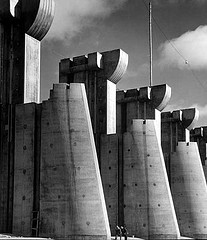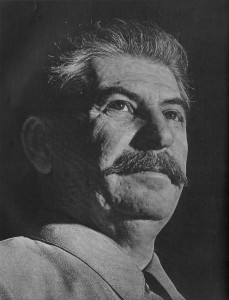Compiled by: Hazel Thompson
Starting Her Career

Steel Plant
by RasMarley, used under 
After graduating from Cornell University, Margaret Bourke White moved to Cleveland, Ohio (Dorfman, 1987). At the time, Cleveland was the center for American industry (Gerber, 2013). She began doing architectural photography of the city’s steel mills (Dorfman, 1987). She came into contact with Otis Steel Factory, and began taking industrial photography (Oden, 2004). She was the first person to document the inside view of these factories, and record with photography the changes and advancements occurring. Her work caught the attention of Henry Luce the founder of Time and Fortune magazine, and she became the first photographer on the staff. She used her photography to capture the “human side” of the news. Instead of poising the picture to try to make everything perfect and happy, White’s photography was about capturing the true emotion and realism (Loughery, 1989).
The Soviet Union
In 1930, Margaret Bourke White’s interests in industrial photography lead her to the newly developing Soviet Union (Dorfman, 1987). She was one of few to witness firsthand and document the communism occurring (Oden, 2004). After her time there she wrote “Eyes on Russia,” and several other articles that were published in the “New York Times (Margaret Bourke-White (1904-1971), 1999).” Margaret was the first Western to photograph the soviet industry after the revolution (Gerber, 2013).

1936 LIFE First Cover
by Chuck_893, used under 
Life Magazine
In 1936, Life Magazine hired Margaret Bourke White as their first ever photojournalist (Loughery, 1989). Photojournalism is where pictures outweigh text. It is commonly found in magazines or other forms of entertainment news. In November of 1936, she published Life’s first cover. It was a photograph of Fort Peck Dam (Loughery, 1989). Margaret Bourke White was changing the way news was presented, and the style that photographs were taken.
Czechoslovakia
In 1938, Margaret Bourke White, was given an assignment by Life to travel with Eric Caldwell, White’s second husband, for five months in Czechoslovakia (Oden, 2004). After her time there, Margaret published “north of Danube” in 1939. It talked about the anti-Semitism in Europe (Gerber, 2013).

Stalin
by Samsebeskazal, used under 
The Soviet Union Again
In 1941, Germany broke its non-aggression pact with the Soviet Union. Margaret was the only foreign photographer in Moscow when Germany invaded July 19th. She was one of few to capture it all on camera. In 1942, White wrote “Shooting the Russian War” on the event. Also in 1943, she put Stalin on the cover of Life the March edition. It was her first experience being in the frontline, taking huge risks to capture every shot (Gerber, 2013).
U.S. Air Force
Margaret Bourke White was the first woman to go along with the U.S. Air Force to photograph their work. She was the first U.S. woman allowed to work in combat zones (Gerber, 2013). She was known to Like Magazine staff as “Maggie the Indestructible (Cosgrove).” There was no limit when it came to Margaret snapping a photograph. She was always willing to risk it all (Dorfman, 1987).
Buchenwald Concentration Camp

Buchenwald during the Nazi Holocaust
by Narayan Hearn, used under 
Margaret Bourke White traveled to Germany with General George S. Patton and Eric Schwab in 1945. While there she witnessed the Buchenwald Concentration Camp. She stated, “Using a camera was almost a relief. It interposed a slight barrier between myself and the horror in front of me” (Cosgrove). White was one of few to want to photograph the horrors of the war (Cosgrove). The pictures she took, have told more of the story about the emotional torture people were enduring more than a book ever could. After seeing this concentration camp, White published “Dear Fatherland, Rest Quietly” in 1946. This was later used in the Nuremberg Trails against Nazi Germany (Gerber, 2013).
Portrait of Myself
Margaret Bourke White wrote an autobiography in 1963 titled “Portrait of Myself.” It described all of the historical events that she encountered, and the people she interacted with, like Stalin and Churchill. The book was on the New York Times nonfiction bestseller list for three weeks (Gerber, 2013). White will forever be remembered for her works through her novel, but also by the number of museums that feature her work. The list of museums includes Brooklyn Museum, Cleveland Museum of Art, Museum of Modern Art in New York, and Library of Congress (Oden, 2004).
Margaret Bourke White was a revolutionist. She ventured outside the norm and changed the style of photographs. White was not the first person to be on the frontline taking photographs of WWII, but was also a female (Cosgrove). Her photographs were not meant to be cheerful, and uplifting. They were to be powerful and informative on the true events occurring in Europe.
Cosgrove, B. (Ed.). (n.d.). Maggie the Indestructible: Bourke-White’s Breathtaking Legacy. (TIME, Producer) Retrieved March 26, 2014, from LIFE: life.time.com/photographers/margaret-bourke-white-a-legendary-photographers-legacy/#1
Dorfman, E. (1987, March). Out to Capture the World. Retrieved March 26, 2014, from JSTOR: www.jstor.org/stable/10.2307/4020071?Search=yes&resultitemclick=true&searchText=margaret&searchText=bourke
Gerber, L. (Ed.). (2013, August 13). Margaret Bourke-White. Retrieved March 26, 2014, from Cosmopolis: www.cosmopolis.ch/english/art/e0015700/margaret_bourke_white_e01570000.htm
Loughery, J. (1989). Woman’s Art Journal. Retrieved March 26, 2014, from JSTOR : www.jstor.org/stable/view/10.2307/1358220?Search=yes&resultltemClick=true&searchText=margaret&searchText=bourke
Margaret Bourke-White (1904-1971). (1999). (R. R. Perlin, Producer, & National Endowment for the Arts) Retrieved March 26, 2014, from American Art: www.phillipscollection.org/research/american_art/bios/bourkewhite-bio.htm
Oden, L. (2004). Margaret Bourke White. Retrieved May 26, 2014, from International Photography Hall of Fame and Museum : www.iphf.org/hall-of-fame/margarer-bourke-white/
Vials, C. (2006). The Popular Front in the American Century: Life Magazine, Margaret Bourke-White, and Consumer Realsim, 1936-1941. (T. O. University, Producer) Retrieved March 26, 2014, from American Periodicals: muse.jhu.edu/journals/american_periodicals/v016/16.1vials.htm